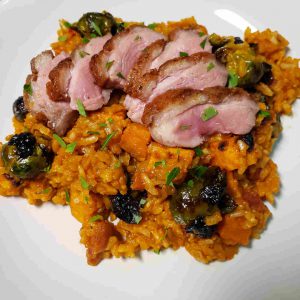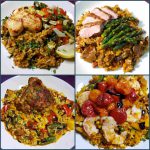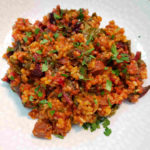A Bit About Traditional Paella
Paella may be Spain’s most famous dish. It is a rice dish featuring saffron and plenty of proteins. Many in the United States think of paella as a seafood dish. However, the original paella, from Valencia, did not include seafood. Rabbit, chicken and/or snails were the traditional proteins. The dish was prepared outside, over an open fire by farm laborers and eaten straight from the pan. Cooking over an open fire added a smokey nuance to the dish. As the dish spread from Valencia, the ingredients changed with the regions and hence seafood became a common component in paella variations. While the proteins have a strong presence, paella is a rice dish. Traditionally it is made with Spanish Bomba rice.
Some take the purism of paella very seriously, up to the level of death threats to those who suggest things outside of tradition. Seriously, when celebrity chef Jamie Oliver suggested the use of chorizo in paella, he received death threats. Another example of how seriously some take the tradition is seen in the Paella Wiki (wikipaella.org). The web site is dedicated to the tradition of paella, down to the 15 steps of how to eat paella. To see what ingredients are acceptable in traditional paella, visit http://wikipaella.org/receta/public/resultados. Sure enough, Spanish chorizo is absent from the traditional recipes.
WikiPaella.org defends the specific ingredients in traditional paella recipes, 365 days of the year, by stating “Thanks to greenhouses, refrigerators, and factory farms, these common ingredients reach all homes and restaurants at any time of the year.” I certainly make use of the fridge and freezer, but I prefer to use local and seasonal ingredients. Maybe they would have some acceptance for my methodology given my goal of using what is at hand. As they state, in The DNA of Valencian Paella, before the recipes crystalized, “At first in history, the Valencian Paella was born as a dish that is the result of the intelligence of the housewife, which makes it possible to take advantage of everything and in turn, … wisely combining rice, legumes, vegetables and animal protein … [which they] had at their fingertips, depending on the harvest of each season, hunting, or simple opportunism.”
Traditional Paella Cooking Method
The traditional pan used to cook paella is two handled, broad and shallow, and made of thin metal which heats very quickly. That pan is also called a paella. In fact, paella is the Catalan word for pan. In the US we often call this pan a paella pan, but technically, that’s redundant. The traditional pan, being broad and shallow, maximizes the surface area. It maximizes the evaporation of cooking liquid, yielding a dry texture. A traditional paella should yield rice that is al dente, dry, and separate. It is very different from a creamy risotto. The pan also maximizes the amount of rice which comes into direct contact with the pan itself. Once the cooking liquid is added, the rice is not stirred. This technique leads to the development of a crispy, caramelized layer of rice at the base of the pan. That layer is called the socarrat, and it is considered the best part of the whole dish.
Traditionally, paella is served communally, directly from the pan. The thin metal of the pan not only heats quickly, it also cools quickly, so the cooking process stops soon after removal from heat. The paella is placed in the center of the table, and each diner mentally maps out their triangular share of the dish.
A Bit About My Paella
My paella is not traditional. I use the stovetop and the oven, not an open fire or a grill. I use an enameled cast iron braiser, not the traditional pan. I use forbidden ingredients and the wrong rice. I often make the dish vegetable forward, and I try to highlight seasonal vegetables from the farmers’ market or my garden.
To get the full scoop on how I make paella, head over to my Paella Mother Dish Technique.



